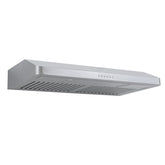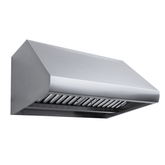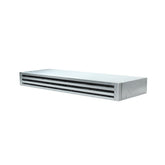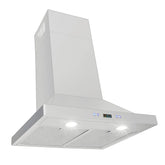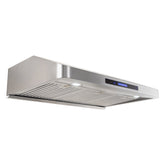Table of Contents
- Inspect and Test Your Range Hood
- Mark the Center and Corners
- Trace and Cut Hole for Ductwork
- Pull Ductwork Through Ceiling
- Install Electrical Wiring
- Install Ceiling and Support Brackets
- Install Chimney Sleeves
- Mount the Range Hood
- Secure and Finalize Installation
- Install Grease Filters
- Frequently Asked Questions
Venting a range hood through the ceiling might seem complicated at first. But, with the right tools and guidance, anyone can do it.
If you want to install a range hood vent through the ceiling, you are most likely installing an island range hood. An island range hood is a freestanding kitchen fan that you mount above your island. The ductwork runs through your ceiling to the outside of your home.
Here is a helpful video on how to install an island vent hood. This video features our PLFI 520, a convertible vent hood that has a pretty universal installation process.
What You Need
- Level
- Tape measure
- Drill or screwdriver
- Marking pen or pencil
- Aluminum duct tape
- Drywall saw
- Plumb line
- Utility knife
Inspect and Test Your Range Hood
Make sure you have everything you need in the box. If you are missing parts, call the distributor or manufacturer for a replacement. Then, remove the hood from the box and inspect it for scratches and dents. It is possible that the hood was damaged en route to your home after it left the warehouse. If so, call the supplier to ask for a replacement hood.
Here is a helpful video to show you exactly what you need to do before you install your vent hood.
We also laid out all the steps in this article.
Mark the Center and Corners
Once you’ve marked the center and four corners of your range on the ceiling, connect them using a pencil and a straight edge. Then, line up the center of the ceiling mounting bracket with the center point you just drew. Finally, outline the ceiling bracket with a pencil. Also, mark the four holes in the ceiling bracket where you will drill the screws.

Trace and Cut Hole for Ductwork
It will be easier to cut a hole through your ceiling if you have traced your ductwork. Otherwise, you may struggle to make a hole that is the exact size you need.
Pull Ductwork Through Ceiling
When cutting the hole for your ductwork, do not follow the pencil line that you marked. Instead, cut a hole about an inch larger than the markings you made. This will make it much easier for you to thread the ductwork through the hole.
Install Electrical Wiring
Before you get too far into the installation process, ensure that you can run electricity to it without too much trouble. Make sure you know where you will plug in your vent hood and that you have the necessary extension cords before you proceed with the installation.
Install Ceiling and Support Brackets
Use your drill and mounting screws to attach the ceiling bracket to your ceiling. Pay attention to the markings you made in step two.
Once installed, lightly tug on the ceiling bracket to ensure it’s drilled firmly in place.
Install Chimney Sleeves
Your vent hood should come with four support brackets. Line them all up along the corner of your ceiling mount bracket and look for the screw holes. Drill screws through the open holes to secure them in place.

Mount the Range Hood
Slide the chimney sleeve up the support brackets to the top of your ceiling. There is a screw hole on the top of the support bracket and chimney which you will use to secure it in place.
Install the lower chimney sleeve.
At Proline, most of our ducted range hoods come with two chimney pieces. Slide the second chimney into place and secure it with tape on the outside and inside.
Pull your ductwork and any electrical wires needed to power the hood through the chimney.
Before you attach your range hood, it’s important to thread the ductwork all the way through the chimney. This makes attaching the transition piece easier later in the installation.
Now it’s time to mount your range hood. Also, grab your electrical wires so that it is easy to plug in the range hood when mounting it in the next step.
Secure and Finalize Installation
Grab a friend to help lift your range hood into place because it can be quite heavy. Before lifting the range hood into place, attach the transition piece to the top of the hood. This will make it easier to connect your ductwork.
13. Using two screws for each bracket, secure the range hood to the support brackets.
Two screws will keep the range hood firmly in place. You can lightly tug on the range hood to check for any loose screws or connections.
14. Remove the tape from your chimney and slide it into place.
Take the tape off of the outside and inside of the hood and slide the chimney down to the top of your hood. Your vent and all electrical wires should be completely concealed.
Install Grease Filters
Depending on your type of vent hood, you will either have baffle filters or mesh filters. First, remove the protective plastic film from your filters.
Then, slide them into the hood by placing the back end in first at an angle and bringing it upward until the filter is completely flat.
If you have baffle filters, be sure to put them in so the baffles are vertical and not horizontal. If they are horizontal, you put them in sideways.
That concludes our guide on installing a vent hood through the ceiling. Before you go, here are a few answers to common questions we hear from our customers about installing a vent hood.
Frequently Asked Questions
Do I vent my range hood through the wall or roof?
You have two options to vent your range hood: through the wall or through the ceiling.
Wall and under cabinet range hoods vent through the wall or ceiling, while island range hoods must be vented through your ceiling.
When choosing how to vent your wall range hood, there are a few things to consider. What is the shortest distance from your kitchen to the outside, with the least amount of turns or elbows? Find this distance and your hood will run at its optimal efficiency.
Second, do you have anything obstructing your ductwork? You want to pick a path that is completely unobstructed to allow for a smooth and affordable installation.
Range Hood Venting Options
Here are a few different ways you can install your wall or under cabinet range hood.
The most common way to install your under cabinet hood is to duct horizontally through the wall. You can run the ductwork horizontally (option 1) or vertically for at least 18 inches and then insert an elbow (option 2).


Or, you may want to run your wall mounted range hood vent through the ceiling instead.

Finally, here is a diagram that shows how your island vent hood will look with the ductwork installed.

For more helpful information on range hood venting options, click here.
Can I install an island range hood directly to the ceiling instead of using a chimney?

It is possible, but not recommended. To mount your hood directly to the ceiling, you would need to be able to get inside the ceiling to mount the range hood. This can be incredibly tricky. It is definitely a two-man job – or more, depending on the size of the hood. To mount the hood directly to the ceiling, you’ll definitely need attic access.
How to Seal a Range Hood Vent
The easiest way to seal a range hood vent is to use some aluminum foil tape. Seal the area that connects your range hood to the ductwork with aluminum tape to make it airtight.
Something like this from Amazon will work great.
Can you raise or lower a ceiling mounted range hood?
No, once you mount your island range hood, it can’t be raised or lowered easily. So you want to install it at the correct mounting height the first time. For the best results, install your island hood between 28 and 36 inches above the cooktop indoors. Or, for outdoor hoods over an island, install them between 36 and 42 inches above the cooktop.
Can you make a 4 x 8 round stack to vent a range hood through the ceiling?
That depends on the range hood. Some hoods use round ducts and some use rectangular ducts. Every hood is different, but typically, as CFM increases, duct size increases. Talk to your manufacturer about which duct size works best for your range hood.
Roof Caps
The last step after your installation is complete is to purchase a roof cap. This will attach to the top of your vent where it terminates at your exterior wall. The goal of a roof cap is to keep dirt, debris, and small animals from getting inside your ductwork. This can decrease your hood’s efficiency.
If you vent your hood through an exterior wall, then you need a wall cap to seal off your ductwork.
Can you vent a range hood into the attic?
No, the buildup of harmful toxins in your attic may result in long-term damage to your health. It is always preferable to vent your range hood to the outside.
Who can install a range hood?
Anyone can install a range hood. We have several installation videos on our website that outline the full process in anywhere from 10 to 30 minutes. The full installation lasts around one to two hours. Most people should be able to install their range hood within this time frame. But, this depends on your expertise and how comfortable you are DIYing. If you don’t have any help, the installation may take over two hours, but it is still doable. Mounting the hood and lifting it into place will be the most difficult part.
Is it easy to install a range hood?
That depends on how comfortable you are with hands-on installation work. Our instructional videos include a wealth of information to help you complete your installation. But, if you are not comfortable with it, a contractor should be more than willing to install your hood for you.
How much does it cost to have a range hood installed?
Typically it costs between $200 and $500 to install your range hood. Island range hoods tend to be more expensive than wall or under cabinet range hoods.
For more information on range hood installation cost, check out this article.
Thanks for reading our article on how to install a range hood vent through the ceiling. For more advice on installing your vent hood, check out more articles below.
How to Build a Mounting Bracket to Hang a Range Hood Over an Island
You will need four metal pieces called support brackets to hang your range hood over an island. The support brackets attach to a chimney mounting bracket that should come with your range hood. Once you’ve installed the support brackets, you can use grabber screws to secure the island hood in place on all sides.
Can an acoustic ceiling go over a kitchen hood?
Yes, you shouldn’t have any problems installing a kitchen hood in a room with an acoustic ceiling. In fact, acoustics are designed to reduce echo so it may even dampen the sound of your range hood blower. If the acoustic panels are close to the hood, you may have to clean them pretty consistently. Or, you can keep your hood on a higher speed to ensure that all the grease and dirt vents to the outside.
Need help with knowing which range hood to choose? Explore our buyer guide.
Read More